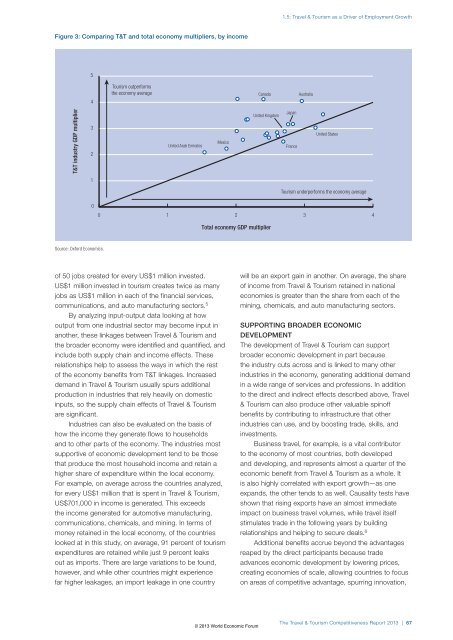The Travel & Tourism Competitiveness Report 2013
The Travel & Tourism Competitiveness Report 2013
The Travel & Tourism Competitiveness Report 2013
You also want an ePaper? Increase the reach of your titles
YUMPU automatically turns print PDFs into web optimized ePapers that Google loves.
Figure 3: Comparing T&T and total economy multipliers, by income<br />
T&T industry GDP multiplier<br />
5<br />
4<br />
3<br />
2<br />
1<br />
0<br />
Source: Oxford Economics.<br />
<strong>Tourism</strong> outperforms<br />
the economy average<br />
United Arab Emirates<br />
Mexico<br />
of 50 jobs created for every US$1 million invested.<br />
US$1 million invested in tourism creates twice as many<br />
jobs as US$1 million in each of the financial services,<br />
communications, and auto manufacturing sectors. 5<br />
By analyzing input-output data looking at how<br />
output from one industrial sector may become input in<br />
another, these linkages between <strong>Travel</strong> & <strong>Tourism</strong> and<br />
the broader economy were identified and quantified, and<br />
include both supply chain and income effects. <strong>The</strong>se<br />
relationships help to assess the ways in which the rest<br />
of the economy benefits from T&T linkages. Increased<br />
demand in <strong>Travel</strong> & <strong>Tourism</strong> usually spurs additional<br />
production in industries that rely heavily on domestic<br />
inputs, so the supply chain effects of <strong>Travel</strong> & <strong>Tourism</strong><br />
are significant.<br />
Industries can also be evaluated on the basis of<br />
how the income they generate flows to households<br />
and to other parts of the economy. <strong>The</strong> industries most<br />
supportive of economic development tend to be those<br />
that produce the most household income and retain a<br />
higher share of expenditure within the local economy.<br />
For example, on average across the countries analyzed,<br />
for every US$1 million that is spent in <strong>Travel</strong> & <strong>Tourism</strong>,<br />
US$701,000 in income is generated. This exceeds<br />
the income generated for automotive manufacturing,<br />
communications, chemicals, and mining. In terms of<br />
money retained in the local economy, of the countries<br />
looked at in this study, on average, 91 percent of tourism<br />
expenditures are retained while just 9 percent leaks<br />
out as imports. <strong>The</strong>re are large variations to be found,<br />
however, and while other countries might experience<br />
far higher leakages, an import leakage in one country<br />
United Kingdom<br />
1.5: <strong>Travel</strong> & <strong>Tourism</strong> as a Driver of Employment Growth<br />
<strong>Tourism</strong> underperforms the economy average<br />
0 1 2 3 4<br />
Canada<br />
Total economy GDP multiplier<br />
© <strong>2013</strong> World Economic Forum<br />
Japan<br />
France<br />
Australia<br />
United States<br />
will be an export gain in another. On average, the share<br />
of income from <strong>Travel</strong> & <strong>Tourism</strong> retained in national<br />
economies is greater than the share from each of the<br />
mining, chemicals, and auto manufacturing sectors.<br />
SUPPORTING BROADER ECONOMIC<br />
DEVELOPMENT<br />
<strong>The</strong> development of <strong>Travel</strong> & <strong>Tourism</strong> can support<br />
broader economic development in part because<br />
the industry cuts across and is linked to many other<br />
industries in the economy, generating additional demand<br />
in a wide range of services and professions. In addition<br />
to the direct and indirect effects described above, <strong>Travel</strong><br />
& <strong>Tourism</strong> can also produce other valuable spinoff<br />
benefits by contributing to infrastructure that other<br />
industries can use, and by boosting trade, skills, and<br />
investments.<br />
Business travel, for example, is a vital contributor<br />
to the economy of most countries, both developed<br />
and developing, and represents almost a quarter of the<br />
economic benefit from <strong>Travel</strong> & <strong>Tourism</strong> as a whole. It<br />
is also highly correlated with export growth—as one<br />
expands, the other tends to as well. Causality tests have<br />
shown that rising exports have an almost immediate<br />
impact on business travel volumes, while travel itself<br />
stimulates trade in the following years by building<br />
relationships and helping to secure deals. 6<br />
Additional benefits accrue beyond the advantages<br />
reaped by the direct participants because trade<br />
advances economic development by lowering prices,<br />
creating economies of scale, allowing countries to focus<br />
on areas of competitive advantage, spurring innovation,<br />
<strong>The</strong> <strong>Travel</strong> & <strong>Tourism</strong> <strong>Competitiveness</strong> <strong>Report</strong> <strong>2013</strong> | 67

















